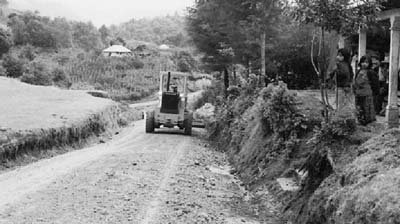

This guide provides a detailed description of the methodology and procedures involved in the third phase of RuralInvest; that is, the phase of formulation and evaluation of detailed projects. Two prior modules exist offering similar support for the tasks of diagnosis and identification (Module 1) and the preparation of project profiles (Module 2). Each module is provided with a technical manual and an instructor’s guide.
Normally, it is recommended that formulation and evaluation be carried out only after the corresponding Module 1 and 2 field work has been completed. However, Phase I (corresponding to Module I) may not always be necessary, and where the proposal is derived from a single family or individual, or in those cases where it is clear that the proposal represents the wishes and priorities of the applicants, it may be possible commence with Module 2.
The manual also highlights the importance of supporting the process that follows formulation and evaluation. Even once the financial committee of the supporting agency has approved the investment proposal, there remain many challenges to be faced by the applicants before they can initiate the project. It is hoped that these needs will be considered in greater detail in a proposed latter manual, which is to focus on the execution of small rural projects.
The formulation and evaluation phase comprises seven main elements, described below:
1. Estimation of demand and benefits: This task determines the potential benefits that result from the investment. In projects that generate saleable products, the size and nature of market demand is estimated. In the case of non-income generating projects, the beneficiaries must be identified and the impact of the investment on those beneficiaries estimated. In both cases, the exercise helps define the scope of the investment and its characteristics.
2. Evaluation of the technology: The proposed technology is reviewed in light of the results of the evaluation of demand and benefits, in order to ensure that it is appropriate. The need for maintenance, repairs and machinery replacement and the possibility of alternate technologies is also considered.
3. Sustainability and environmental impact: This task considers the sustainability of the project not only from the perspective of natural resource usage and environmental impact. It is also critical for those projects not generating substantial income streams, where there is a need for operational support once the investment is completed: a school is not sustainable if there is no provision for paying the teacher’s salary. For investments with the likelihood of a negative environmental impact, impact mitigation measures, or ways to modify the project design to avoid these impacts, must be identified.
4. Estimation of costs and income: The next step is to define and calculate the costs and income associated with the investment and operation of the project. Although this may be a relatively easy step for simple investments, the introduction of variables such as perennial crops, livestock breeding or other complex activities can create significant complications.
5. Financing the investment: With costs and income calculated, the financing needs can be considered, both for investments and for the working capital needed for daily operations.
6. Organization and investment management: The most profitable project will fail if it lacks an adequate structure for directing and managing operations. The identification of these management needs is an integral element in the formulation and evaluation effort.
7. Evaluation and preparation of recommendations: With all the individual elements of formulation and evaluation gathered, the full project evaluation can be undertaken. However, the results obtained only tell part of the story. It is also necessary to identify the key factors that will influence the eventual success of the investment and to determine the risk that these factors may differ from those foreseen in the project design, affecting the success of the project.
8. Preparation for the investment: Aspects to be considered here are: task scheduling, negotiations with the financing sources, supervision of construction and other activities essential to the execution of the project.
Given the custom software developed for RuralInvest, it is not necessary for users to be computer experts. However, access to a relatively modern computer and some level of familiarity with the Microsoft Windows operating system are indispensable. The use of a computer with a minimum of Microsoft Windows 95 (or later version) is recommended whenever possible.
Two principal types of operations are permitted by the software, the entry of project profiles (prepared in the field during Phase II) and the formulation of detailed project proposals. Electronic versions of the profiles can be used for management information purposes and can be sorted by key characteristics. They can also pass basic information automatically to the screens used for detailed formulation.
The detailed formulation option within the software permits automatic calculation of many of the steps necessary in the determination of project feasibility. Different screens exist for income generating and non-income generating investments. Once all required screens have been completed the software can generate project summaries or full project descriptions of between 8-25 pages, depending on the scale and complexity of the project. Information can also be passed from a computer in a local office or agency to a central headquarters, where projects prepared by different technicians can be grouped together. It is hoped that there will shortly be supplementary software available to permit the Management Information Systems (MIS) department of a Ministry, bank or large project to output detailed breakdowns of rural investment proposals by location and type of investment.
Finally, by subsequently replacing data used in the project models with real data once projects are in implementation, RuralInvest permits users to see clearly the differences between the project as envisaged when in preparation, and the project as it occurred in the real world. This comparison can be invaluable in helping to identify weaknesses in the project formulation process, and showing where more conservative assumptions or more detailed analysis, are necessary.
The computer software currently used by RuralInvest is largely developed in Microsoft Visual Basic with database functions derived from MS Access, and conforms to the structure used for the MS Windows Explorer package, which is found in all Windows desktops. While Windows is essential to run the RuralInvest package, there is no need for the user to have MS Access on his or her computer, as the package is self-executing (that is to say it carries its own programming code). A User’s Manual provides additional support for the software, but the menu-driven structure and on-screen help renders the software easy to use once the underlying concepts have been understood (the key role of the training course).
The software offers two levels of entry, including user and administrator. Those with administrator-level access can modify a number of data entry parameters and output screens to meet the specific conditions of the country or institution supporting RuralInvest. For example, it is possible to define default currencies, administrative levels (e.g. municipalities, districts, provinces, states, etc.), regional or local offices, and project categories. It is also possible to set defaults for the financing aspects related to the investments, such as minimum and maximum duration of loans, the availability of grace periods, interest rates etc.
RuralInvest cannot work miracles. The quality and value of the final proposal generated as a result of using RuralInvest depends, to a large extent, on the care and thoroughness with which the different stages of analysis have been completed. Poor information entered will result in poor results generated at the end of the process.
In some cases, specialized information is needed to determine such aspects as market characteristics, probable yields or the suitability of the zone for the proposed crop or product. It is therefore recommended that when a proposal deals with a matter involving information that goes beyond the knowledge or capability of the group and its advisor (for example, determining if the flow of a stream is sufficient to support an irrigation system of a determined size), the opinion and support of experts in the particular field should be sought. Organizations and agencies using RuralInvest should make allowance for the cost of such supplemental technical input and it can be vital for project integrity.
Of even greater importance is the treatment of much more common figures: yields, prices and costs. The computer software used in RuralInvest has only a very limited ability to identify and reject incorrect or over-optimistic numbers. Any proposal can appear attractive if the technician inserts very optimistic numbers into the formulation process and if she/he fails to give the necessary importance to such integral evaluations as marketing, technology, sustainability, management, etc., and treats them as unimportant tasks to be completed as quickly as possible. If the technician states that cheese from the dairy plant will sell for US$2.50/kilo when a realistic price is closer to US$1.25, the result is likely to be an apparently attractive project that fails once it is put into effect. For this reason it is very important: (a) to not inflate figures to generate positive outcomes, simply because the first numbers used did not give the desired result, and; (b) identify those elements which are most likely to affect the overall feasibility of the project (yields, prices etc.) and use the power of the computer to run the model various times under different assumptions. This will soon show which changes could result in a failure of the project (this is discussed in more detail in Chapter 8 of this manual).
Remember: The recommendations that you present to the financing agency may have a profound impact on the lives of the applicants. If you fail to do your job properly, many lives can be adversely affected.